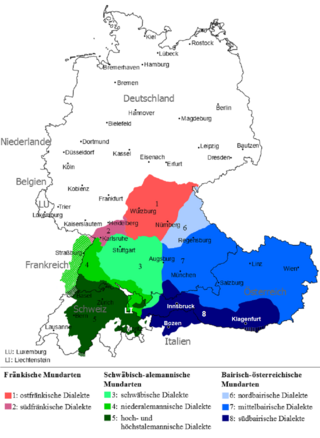| Revision as of 23:40, 6 April 2020 editApisite (talk | contribs)Extended confirmed users1,846 editsNo edit summary← Previous edit | Revision as of 02:38, 10 April 2020 edit undoDuanefromri (talk | contribs)445 editsmNo edit summaryNext edit → | ||
| Line 25: | Line 25: | ||
| In the transitional area between ] in the northwest and the ] dialects in the southeast, East Franconian has elements of ] and ]. The same goes only for ] in adjacent ]. East Franconian is one of the German dialects with the highest number of speakers. | In the transitional area between ] in the northwest and the ] dialects in the southeast, East Franconian has elements of ] and ]. The same goes only for ] in adjacent ]. East Franconian is one of the German dialects with the highest number of speakers. | ||
| The scope of East Franconian is disputed, because it overlaps with |
The scope of East Franconian is disputed, because it overlaps with neighbouring dialects like Bavarian and ] in the south, ] in the west and ] in the north. | ||
| East Franconian is researched by "Fränkisches Wörterbuch" project in Fürth, which is run by Bayerische Akademie der Wissenschaften and Erlangen-Nuremberg |
East Franconian is researched by the "Fränkisches Wörterbuch" project in Fürth, which is run by Bayerische Akademie der Wissenschaften and Erlangen-Nuremberg University. | ||
| == References == | == References == | ||
Revision as of 02:38, 10 April 2020
| This article needs additional citations for verification. Please help improve this article by adding citations to reliable sources. Unsourced material may be challenged and removed. Find sources: "East Franconian German" – news · newspapers · books · scholar · JSTOR (December 2009) (Learn how and when to remove this message) |
You can help expand this article with text translated from the corresponding article in German. (November 2018) Click for important translation instructions.
|
| East Franconian | |
|---|---|
| Ostfränkisch | |
| Native to | Germany (Bavaria, Thuringia, Saxony, Baden-Württemberg, Hesse) |
| Native speakers | 4,900,000 (2006) |
| Language family | Indo-European
|
| Writing system | Latin (German alphabet) |
| Language codes | |
| ISO 639-3 | vmf |
| Glottolog | main1267 |
 1: East Franconian 1: East Franconian | |
East Franconian (Template:Lang-de), usually referred to as Franconian (Fränkisch) in German, is a dialect which is spoken in Franconia, the northern part of the federal state of Bavaria and other areas in Germany around Nuremberg, Bamberg, Coburg, Würzburg, Hof, Bayreuth, Meiningen, Bad Mergentheim, and Crailsheim. The major subgroups are Unterostfränkisch (spoken in Lower Franconia and southern Thuringia), Oberostfränkisch (spoken in Upper and Middle Franconia) and Südostfränkisch (spoken in some parts of Middle Franconia and Hohenlohe).

In the transitional area between Rhine Franconian in the northwest and the Austro-Bavarian dialects in the southeast, East Franconian has elements of Central German and Upper German. The same goes only for South Franconian German in adjacent Baden-Württemberg. East Franconian is one of the German dialects with the highest number of speakers.
The scope of East Franconian is disputed, because it overlaps with neighbouring dialects like Bavarian and Swabian in the south, Rhine Franconian in the west and Upper Saxon in the north.
East Franconian is researched by the "Fränkisches Wörterbuch" project in Fürth, which is run by Bayerische Akademie der Wissenschaften and Erlangen-Nuremberg University.
References
- East Franconian at Ethnologue (18th ed., 2015) (subscription required)
See also
External links
- Linguistic atlas of Middle Franconia (in German)
- Linguistic atlas of Lower Franconia (in German)
- Bayerische Akademie der Wissenschaft (in German)
This article about Germanic languages is a stub. You can help Misplaced Pages by expanding it. |